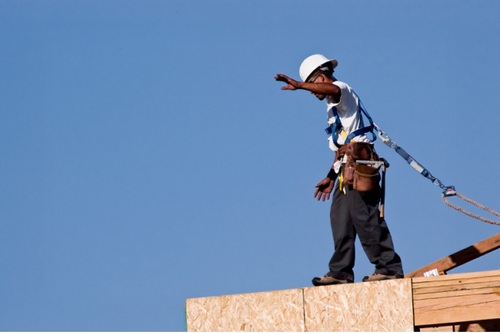Fall Clearance for Construction Workers
Since OSHA now requires all construction workers to have fall protection when they are more than 6 ft. from the next work level, there is ongoing confusion about how to protect workers operating with minimal fall clearance. The most popular option for working in areas like this are the self-retracting lifelines, or SRLs. But can they protect workers when they are just over the 6 ft. threshold?
It is generally understood that for work areas with less than 18.5 ft. of fall clearance, use of traditional shock-absorbing lanyard is out. What is more difficult to understand is how quickly a typical SRL will engage in the event of a fall, and are workers protected when working in an area with 6 to 18.5 feet of clearance?
We recently received an email from a customers who had bought 100 Nano-Lok SRLs from DBI-SALA and was worried that when their workers were operating less than 18 ft. off the ground, they might not be high enough to protect their workers in the event of a fall.
"Well we ordered these double retractables, but they have the shock absorber that extends from 3-4 feet if a fall takes place. Say for example: a 6 foot worker working at 8 feet - if he fell would he actually hit the ground after the shock absorber is activated?"
The answer lies in the relation of the worker to the overhead anchorage point. The further from directly overhead the worker moves, the greater the amount fall clearance that will be required.
While it's true the shock pack on a Nano-Lok SRL extends up to 3-4 ft. in the event of a serious fall, and that DBI-SALA uses the longest possible stopping distance to calculate the braking distance of the unit, SRLs are really the best possible option - short of fall restraint - currently available on the market. Fall restraint systems keep a worker tethered so there is no chance of them falling in the first place, and they severely restrict the work people are able to do, especially on new construction.
Furthermore, in practice, the actual fall distance when using an SRL like the Nano-Lok is something closer to between 12 and 18 inches. A worker will generally be safe as long as his feet are 4 ft. above the next lower level. To the extent that the anchor point is off-set overhead, this distance needs to be adjusted. A chart in the instructions from DBI-SALA details this formula graphically.
One final point on this matter. I'm not an engineer, nor am I an at-height worker. But I do have plenty of training and experience with self-retracting lifeline devices. It's my opinion that an SRL that doesn't engage for 30 inches is likely not traveling at a sufficient velocity to engage the brakes until it gets moving. If this is the case, even taking into account some degree of swing fall, I find it unlikely the shock pack would rip to the fullest extent of its length.
This is simply another way of saying whether you call them retractables, self-retracting lifelines, or personal fall limiters, they are the best fall protection for construction workers currently available, and they are what construction workers need when working over 6 feet, but under 18.5.
If you have more questions about fall clearance, or OSHA safety standards for the construction industry, please don't hesitate to call or visit us online at pksafety.com.
Recent Posts
-
Promoting Safety: National Work Zone Awareness Week is April 15-19, 2024
Each year, the National Work Zone Awareness Week (NWZAW) places the spotlight on the importance o …Apr 11th 2024 -
Understanding 4 Gas Monitors: How They Work & Why They Are Important
In today’s increasingly dynamic industrial landscape, 4 gas monitors have emerged as critical com …Apr 8th 2024 -
April Showers Require Workers to Wear Hi-Vis Safety Rain Gear
While April showers bring May flowers, they also bring challenges, particularly for those working …Apr 1st 2024





